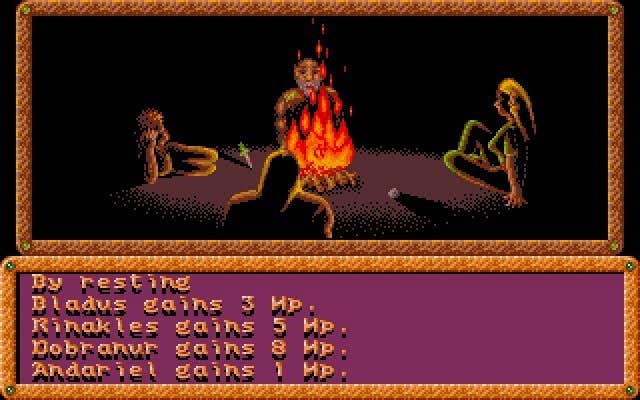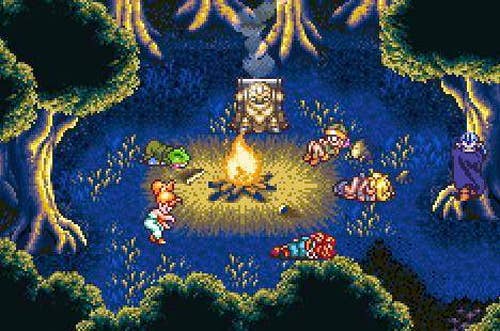From Chrono Trigger to Dark Souls Remastered: The Evolution of the Bonfire in Games
We trace the use of the campfire in games from its earliest days to Dark Souls and beyond.
This article first appeared on USgamer, a partner publication of VG247. Some content, such as this article, has been migrated to VG247 for posterity after USgamer's closure - but it has not been edited or further vetted by the VG247 team.
"The Beacon Fire stands for many things," Dark Souls creator Hidetaka Miyazaki told the PlayStation Blog back in 2011, not long after the future classic was officially announced. "[I]t's probably the one place in Dark Souls where users can relax just for an instant. In this cold, dark world, the Beacon Fire is a place of warmth. It's one of the few locations in the game that is heartwarming. It expresses this dark fantasy world I'm trying to create."
The image of a knight sitting cross-legged in front of a lonely fire has become one of the iconic images of the series, and arguably gaming as a whole. Many games have since co-opted this imagery, from survival games to indie darlings like Hyper Light Drifter.

It's an image that instantly conveys a wide range of emotions. It taps into the most primal part of our history as a species, when we huddled around the fire to escape monsters real and imagined. Even now, we're naturally drawn to the warmth of the campfire. Its crackling flames speak of comfort, warmth, and companionship.
In Kill Bill, the campfire is where Bill relates the story of Pai Mei to his fascinated apprentice, his flute sounding notes of Peter and the Wolf. In O Brother Where Art Thou, the campfire is where the gang dreams of where they will spend their money when they finally find it. And in Easy Rider, it's where the travelers sound the first of many laments about the decline of the American culture of freedom.
In video games, the campfire scene has been a familiar sight going back to at least the 16-bit era in the late 80s and early 90s, though its application was a bit more prosaic back then. In Golden Axe, little gnomes would appear to rob your character in the night, and you would subsequently whack them until they gave up a magic potion. In Secret of Monkey Island 2, Guybrush Threepwood finds two pirates named Bart and Fink sitting around a fire on Scabb Island, then proceeds to bore them with tales of battling the pirate LeChuck.
Unsurprisingly, early video game campfire scenes mainly found their best expression in the first RPGs—one of the few genres to play with narrative in a meaningful way in the 80s and 90s. One gaming memory that still sticks out to me is Cecil, Tellah, and Rydia from Final Fantasy IV huddled around a fire in a deep cave; Tellah lamenting that his daughter had run away with a (spoony) bard, and Cecil sharing his quest for the SandRuby to save Rosa. It wasn't anything more than a convenient vehicle for exposition, but in an age when video game stories often didn't get much more complicated than Bad Dudes Saving the President, it stood out.
When they weren't being used to further the story, they were a useful way to recover health. Role-playing games from Ultima 4 to Final Fantasy to Dragonflight would let you rest by the campfire to heal your wounds. It was often with a huge sigh of relief that you would stumble out of a dungeon and make camp on the overworld to heal your wounds. Or you would camp at a conveniently placed save point, knowing that a strong foe waited just beyond.

One of the most powerful of these early campfire scenes could be found in Chrono Trigger. In what has become an iconic image for the series, the party reunites with a now-400-year-old Robo, who suggests that the time gates are not connected to Lavos, the story's main villain. He instead gets philosophical as he speculates, "The different events over time, that we have witnessed. It is almost as if some entity wanted to relive its past." The rest of the party weighs in on life, death, and fate, and we subsequently get a glimpse of Lucca's past, where we witness a tragic accident.
Games were maturing rapidly by 1995. It wouldn't be long before Final Fantasy and Fallout came around to fundamentally change our understanding of storytelling in an interactive medium. Chrono Trigger was daring for its time because it wasn't afraid to get philosophical. It remains one of the greatest examples of video game storytelling to date. And where were all of its themes summed up? Around a campfire.
Companionship and Reflection
As games have evolved, so too have the ubiquitous campfire scenes. Camping was a major part of BioWare's Dragon Age: Origins, for instance, with the campsite being treated as something akin to the Normandy. As in Mass Effect's iconic starship, it's a place to get to know your party members, bond with them, and eventually have sex with them (it always boils down to sex in BioWare's RPGs). Visual clues give you a hint of player personalities, the strongest being Morrigan resolutely sitting outside of the warm circle of light. And as you progress, the campsite becomes steadily more crowded with allies and merchants.
In one of Dragon Age's best scenes, Leliana remembers a song sung to her many years before, when her mother dies. What follows is genuinely beautiful.
The campfire is similarly a moment of bonding in Final Fantasy XV. I would even go as far as to say that it's the best part of an otherwise messy RPG. It lends structure to the open world exploration by introducing fatigue, bringing the boys together around an amazing looking meal. Director Hajime Tabata was so intent on making the camping feel real that he sent an actual crew off to make the game's meals outdoors.
"Camping is one of the base features of XV," Tabata told Kotaku of the importance of camping during Final Fantasy XV's development. "It's a world where time passes from morning to night, so in order to have Noctis and the others who inhabit it be more than just puppets, but living characters players can feel empathy towards, if you have them remain awake all the time, I thought it would be more effective if that was a bad thing." The campfire is a recurring thread right up until the end of the story. And like everything else in Final Fantasy XV, it gets an official sponsor—Coleman, in this case.
All of these campfire scenes, ultimately, bring to mind a sense of companionship. Chrono Trigger is philosophy and reflection; Final Fantasy XV is about friendship, and Dragon Age: Origins is about... well... you know. They all hearken back to that ancient need for safety and community.
Solitude and Safety
Which brings me back to Dark Souls. When the Chosen Undead kneels at the fire for the first time, it's different from the games I just described. It's a signifier of solitude rather than companionship. And yet, despite that, the crackle of the fire is associated with warmth and safety. It keeps the monsters away, even as it isolates you.
Other games have since borrowed this imagery. As I already mentioned, campfires have become a common sight in indie games, not to mention the survival-themed Tomb Raider reboot. Since Dark Souls' initial release, the survival genre has steadily risen in popularity with games like Don't Starve and The Long Dark making campfires a central part of their gameplay. In those games, you actually have to gather the materials necessary to build the fire. If you don't, the monsters or other predators may come (or you might just freeze to death... or go crazy).
Meanwhile, Shovel Knight finishes every level with the hero sitting wordlessly next to a bonfire, dreaming of the lost Shield Knight falling through his arms. The thematic similarities are obvious, even if Yacht Club Games is in some ways reluctant to acknowledge them . In an interview with Game Informer, Sean Velasco downplayed the Dark Souls connections, saying, "[I]t's like what has more charged meaning in it than a solitary knight at his campfire either reliving something that happened or just having a little moment of respite after a big battle? That was one of the key images that anchored the home game. Because before there was Shovel Knight gameplay there was Shovel Knight at the campfire."
Later, Yacht Club posted a joking article accusing Dark Souls (and many other games) of stealing elements like the bonfire from Shovel Knight. I'll admit, this is one of those moments in which it feels like a developer doth protest too much. It's not exactly the same, but it's perhaps no coincidence that campfires are more popular than ever in the wake of Dark Souls.
But while all of these games make amazing use of the warm glow of the campfire in one way or another, the image that sticks with me most is from Stalker: Clear Sky (stylized "S.T.A.L.K.E.R"). Contributor Doc Burford, who counts Stalker as one of his favorite games, describes it this way: "The Zone is uniquely hostile. It is a space that lives. It has a presence. [Stalker] has a uniquely deep AI system that means its NPCs journey throughout the world on their own quests."
"Sometimes, you find them at campfires. They aren't generic AI with patrol routines. They're people who you might have met hours before in another place entirely," he says. "So when they gather, they sit, and play the guitar, and make jokes, and they provide each other (and you) with humanity in a world that is actively out to strip them of that."
These moments are haunting in their beauty, and perhaps most emblematic of what sitting around a campfire can bring to a game. Whether in simple survival, reflection, companionship, or solitude, they take us to our very roots as a species, which is why they inevitably draw such a strong emotional response.
With the launch of Dark Souls Remastered on PC, Xbox One and PS4 earlier today, bonfires are once again in the zeitgeist. Whether as a gameplay mechanic or a simple vehicle for moving the story forward, they have become a major trope in multiple genres, from survival to role playing. And that, perhaps, speaks more than ever to the evolution of gaming as a visual and storytelling medium.











